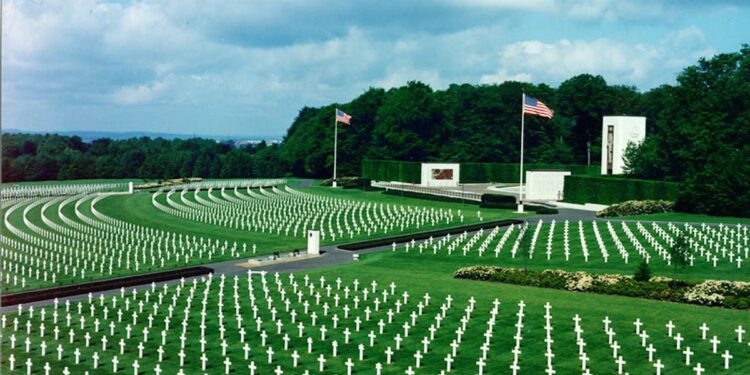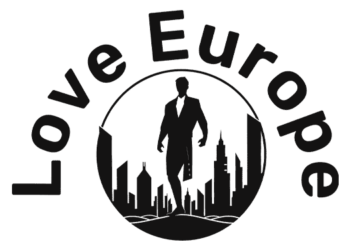Exploring Luxembourg’s World War Two history will take you to the capital, across the country and, possibly, right to your front doorstep. You’ll discover what it was like under Nazi occupation, the legacy of the Battle of the Bulge and the darker side of life in Luxembourg during wartime.
Luxembourg was swiftly invaded and occupied by an encroaching German Empire on its way to invade France during World War One (1914-1918). Having survived four years before Germany lost to the Allies, Luxembourg was again invaded and occupied by Nazi Germany between 1940 and 1945 – and witnessed brutal fighting as the Allies fought to liberate Western Europe.
That’s why memorials to both its own soldiers and those who lost their lives fighting on Luxembourg soil are scattered across the country.
Nestled between Sandweiler and Luxembourg’s international airport, the Luxembourg American Cemetery and Memorial, which commemorates thousands of soldiers, is the most prominent amongst these and a powerful testament to the violence the country witnessed.
But all around the country you’ll find numerous places of commemoration and remembrance to Luxembourg’s soldiers, civilians and liberators – and uncover a darker side of the Grand Duchy’s history whose memory is worth maintaining.
Gate in Diekirch displaying a “Heim ins Reich” banner in 1940 © Photo credit: General Patton Memorial Museum Ettelbrück
Luxembourg wasn’t just meant to be occupied during World War Two, it was supposed to be fully absorbed into the Greater German Reich as a new region. As the groundbreaking Luxembourgish documentary Heim ins Reich illustrates, the country was to be thoroughly “Germanised”: stripped of national culture, Luxembourg was to become an integral part of Germany and its war machine. And as such, Luxembourg could not avoid some of the war’s most harrowing battles and events.
Luxembourg in wartime
While occupied, Luxembourg suffered from extensive Nazi policies and oppression. Tucked away in the Hollerich train station, a permanent installation commemorates Luxembourgers – political dissidents, Jews or both – who were forcibly deported, never to return.
Memorial at Schuman’s Eck © Photo credit: Jean-Michel Muller
The Shoa Memorial Trail in the capital takes walkers past the former headquarters of Luxembourg’s Nazi governor, a Jewish school from where Jewish children were expelled, the Gestapo headquarters and the former site of a synagogue. It’s through initiatives like these that Luxembourgers are reminded of the atrocities the Grand Duchy suffered.
The National Monument of the Solidarity is only a short walk away from the Gëlle Fra, representing the resistance and solidarity of Luxembourgers during the Nazi occupation. Of course, the Golden Lady herself memorialises the thousands of Luxembourgers who volunteered during both World Wars and the Korean War.
On Patton’s Trail
The Allies liberated Luxembourg in September 1944 – although German forces would not give up Luxembourg so easily. Between mid-December 1944 and late January 1945, German forces staged their last counterattack of the war, which Luxembourgers call the Ardennes Offensive and the Anglophone world knows as the Battle of the Bulge.
The frontline in the winter of 1944-1945 stretched from Bastogne in Belgium, through Ettelbruck and Diekirch and down to Echternach. It’s in Ettelbruck that you’ll find the General Patton Memorial Museum and the monument honouring his role in liberating Luxembourg once and for all. Nearby Diekirch is home to Luxembourg’s National Museum of Military History, making the two towns a hotspot for military history in the Grand Duchy.
Helen Patton, grand-daughter of General Patton, at the Luxembourg American Cemetery © Photo credit: Guy Jallay
There are also military history museums in Clervaux and Wiltz, the latter of which is also home to the National Strike Monument. Schumann’s Eck Memorial Site, a few kilometers southwest of Wiltz, commemorates one of Luxembourg’s bloodiest battles.
A rich landscape
There’s actually another cemetery near Sandweiler; the German one, opened in 1955, for the over 10,000 servicemen who fell during the Battle of the Bulge. These soldiers had before been buried all across the country in 150 cemeteries before the German War Graves Commission sought to have as many identified as possible and moved to one place. Nevertheless, many gravestones in the German Military Cemetery simply bear the title “Ein Deutscher Soldat” – A German soldier.
VE Day marked the end of the war in Europe on 8 May 1945. Luxembourg had suffered around 5,700 deaths – about 2% of its total population, the second highest percentage in Western Europe. Luxembourg entered an era of reconstruction, aided by the US through the Marshall Plan, and has built numerous memorials to commemorate the most difficult period in its history.
These memorial sites, big and small, are spread all over the country. You can find an extensive list of them here. Together, they are a testament to a country caught between larger powers during the deadliest war in human history and how Luxembourgers came together to overcome an intense period of hardship and violence.
Besides the history hotspots of Ettelbruck, Diekirch, Wiltz and the capital, almost every corner of the country bears its mark, making Luxembourg’s history during World War II a rich one worth uncovering.
Source link : https://www.luxtimes.lu/luxembourg/on-the-trail-of-luxembourg-s-world-war-two-history/2333945.html
Author :
Publish date : 2023-08-22 07:00:00
Copyright for syndicated content belongs to the linked Source.


